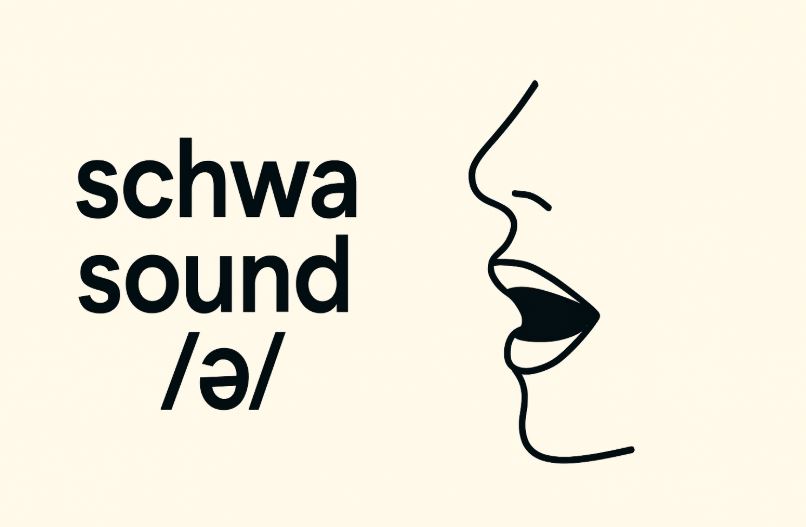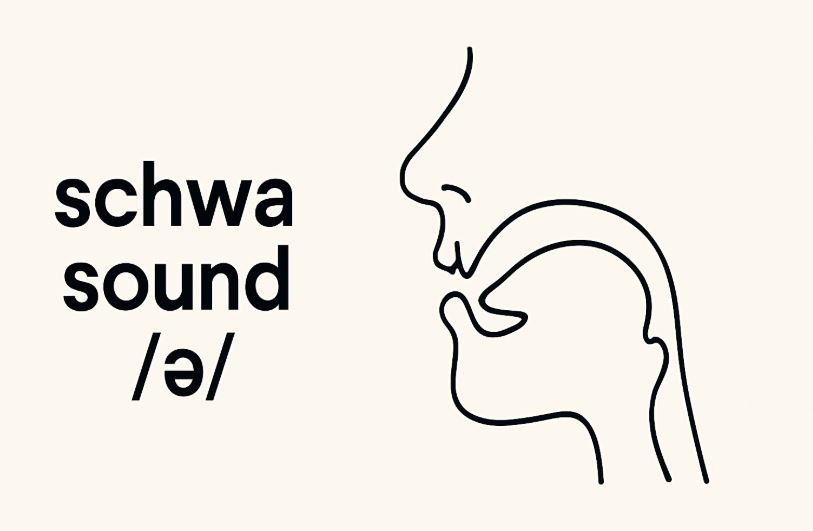
Hey there! I’m Emma, your American Accent Coach—and today, we’re diving into one of the quietest, trickiest, and most important sounds in American English: the schwa sound /ə/.
If you’ve ever wondered why native English speakers seem to skip over certain syllables or mumble parts of words like banana, family, or chocolate, you’re not imagining it. You’re hearing the schwa sound.
This sound might be small and subtle, but it’s everywhere. In fact, the schwa is the most common vowel sound in English—and mastering it can make a huge difference in how natural, fluent, and native-like you sound.
✨ In this guide, we’ll unpack everything you need to know about the schwa—from how it’s made, where it shows up, why it matters, and how to master it with confidence.
Let’s get started!
The schwa sound is represented by the IPA symbol /ə/. It’s a relaxed, neutral vowel that shows up in unstressed syllables.
Phonetically, it’s a mid-central vowel. That means:
Your tongue is in the middle of your mouth
Your lips are neutral (not spread or rounded)
Your jaw is relaxed
Your vocal cords vibrate (it’s voiced)
It sounds like a soft “uh”—but don’t confuse it with the /ʌ/ sound in cup. The schwa /ə/ is even lazier and quicker.
✨ Try this: Say the word banana slowly — /bəˈnænə/. Hear how the ba- and -na are softer and blurrier than the -NAN- part? That’s the schwa in action!

You might be thinking: “It’s just an unstressed vowel—why does it matter?”
Here’s why:
It’s everywhere. Roughly 1 in every 3 vowels in natural spoken English is a schwa.
It drives English rhythm. English is a stress-timed language. We emphasize key syllables and quickly reduce the others—often to schwa.
It hides in plain sight. Any vowel letter (a, e, i, o, u) can be pronounced as /ə/ in an unstressed syllable.
It helps you sound natural. Over-pronouncing every vowel makes your speech sound robotic. Using schwa correctly is key to fluency.
Tongue: Mid-position, neither front nor back, slightly relaxed.
Lips: Neutral—no rounding or spreading.
Jaw: Slightly open.
Voice: On. Your vocal cords vibrate, but not much effort is used.
✨ Think of schwa as the “resting” position of your vocal tract. It’s what your mouth produces when it’s not trying hard to shape a vowel.
If a syllable carries primary or secondary stress, it won’t be a schwa. Period.
Here are some common places where schwa shows up:
about → /əˈbaʊt/
alone → /əˈloʊn/
again → /əˈɡɛn/
banana → /bəˈnænə/
president → /ˈprɛzədənt/
analysis → /əˈnæləsɪs/
sofa → /ˈsoʊfə/
chocolate → /ˈtʃɔklət/
family → /ˈfæməli/ (or /ˈfæmli/ with a dropped schwa)
to → /tə/
a → /ə/
of → /əv/
can → /kən/
and → /ən/ or even just /n/
✨ Pro Tip: Learn to listen for which syllables are stressed. The others are likely reduced—and schwa is the go-to reduction.
Here’s where things get tricky: there is no single letter that represents schwa. Any vowel can become /ə/ when unstressed.
Let’s look at how different letters map to the schwa:
| Letter | Examples | IPA |
|---|---|---|
| A | about, banana, sofa | /əˈbaʊt/, /bəˈnænə/, /ˈsoʊfə/ |
| E | taken, problem, celebrate | /ˈteɪkən/, /ˈprɑbləm/, /ˈsɛləbreɪt/ |
| I | president, pencil, animal | /ˈprɛzədənt/, /ˈpɛnsəl/, /ˈænəməl/ |
| O | occur, harmony, bottom | /əˈkɜr/, /ˈhɑrməni/, /ˈbɑtəm/ |
| U | support, supply, medium | /səˈpɔrt/, /səˈplaɪ/, /ˈmiːdiəm/ |
✨ Takeaway: Spelling won’t always help you. Listening and learning stress patterns will.
English isn’t just about pronouncing individual words. It’s about how words flow together—and the schwa is a big part of that flow.
Function words (like to, for, of, a, and) usually reduce to a schwa unless they’re emphasized.
✅ Natural speech:
“I want to go.” → /aɪ wɑnt tə go/
“She’s one of them.” → /wʌn əv ðəm/
❌ Unnatural:
“I want TO go.”
“She’s one OF them.”
Unless you’re making a point, those full vowels don’t belong there.
Schwa helps smooth transitions between words.
far away → /fɑɹ əˈweɪ/
better idea → /ˈbɛɾɚ aɪˈdiə/
Try saying those word pairs with no pause between them. The schwa keeps your rhythm smooth and natural.

In fast speech, entire schwa syllables can vanish.
Examples:
camera → /ˈkæmrə/
family → /ˈfæmli/
chocolate → /ˈtʃɔklət/
every → /ˈɛvri/
This happens because the schwa is so light and quick—it can drop out entirely, and native speakers still understand the word from context.
✨ Tip: When in doubt, aim for clarity. It’s better to pronounce the schwa than to drop it and lose meaning.
The schwa often appears when a word changes form and stress shifts.
Example:
photograph → /ˈfoʊtəɡræf/
photography → /fəˈtɑɡrəfi/
See how the first syllable goes from FOH- to fuh-? That’s schwa showing up because the stress moved.
Other examples:
nature → /ˈneɪtʃɚ/
natural → /ˈnætʃɚəl/
define → /dɪˈfaɪn/
definition → /ˌdɛfəˈnɪʃən/
✨ Pay attention to word families—knowing one helps you predict the others.
Let’s tackle some frequent errors I see as a coach:
“banana” → /ˈbænænɑ/
✅ Should be /bəˈnænə/
Fix: Relax and reduce the unstressed syllables. Let them blur!
These two sound similar but serve different roles.
/ʌ/ is stressed: cup, love, sun
/ə/ is unstressed: sofa, banana, above
Tip: The quality is similar. The stress is what makes them different.
Not every unstressed vowel becomes schwa. Some stay as reduced /ɪ/ or even [i], like in:
city → /ˈsɪti/ (not /ˈsɪtə/)
happy → /ˈhæpi/ (not /ˈhæpə/)
✨ Tip: Use dictionaries with IPA to check if it’s really schwa.
Here’s a mini training plan you can follow:
Use a dictionary or say the word out loud. The loudest, clearest syllable is the stress. The others are your schwa candidates.
Use apps like ChatterFox or videos with subtitles. Repeat after native speakers. Focus on the vowel reductions.
Say these out loud:
FULL pronunciation vs. reduced
“photograph” → /ˈfoʊtəɡræf/
“photography” → /fəˈtɑɡrəfi/
Read a short paragraph aloud. Record it. Then compare it to a native version. Where are your vowels too strong? Too long?
Say: “buh-NA-nuh, buh-NA-nuh” slowly and musically.
Then try:
“a BUH-tər CUp of COF-fee”
Focus on stressed syllables (capitalized), and let the rest relax.
The schwa sound may be tiny, but it’s mighty.
Learning to hear, recognize, and use schwa correctly will change how you sound—and how you understand English. It’s the secret to:
Natural rhythm
Fluent flow
Clear listening
Confident speaking
So don’t overlook it. Embrace the schwa. Practice it. Celebrate your progress—even when it’s quiet!
You’re not alone in this journey. I’m right here cheering you on.
Let’s keep going. One relaxed “uh” at a time.
—
Need help hearing and using schwa in real speech? Try ChatterFox—our American accent training program that combines real human coaching with AI technology to help you master pronunciation the smart way.
Until next time,
— Emma, your American Accent Coach